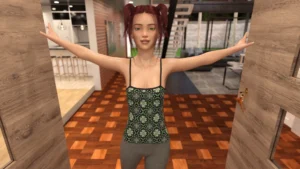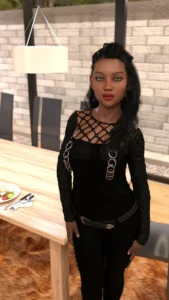
Play Thirty Days
Thirty Days review
Explore the immersive world of Thirty Days, where every decision shapes your story
If you’re curious about Thirty Days, you’re not alone—this choice-driven visual novel has captured attention for its deep narrative, diverse characters, and the sheer variety of outcomes based on your decisions. As someone who’s explored multiple playthroughs, I can tell you that Thirty Days stands out for its replayability and the way it immerses you in the lives of sheltered twins, Alex and Kayla, as they navigate a month of new experiences. Whether you’re drawn to character development, branching storylines, or the freedom to shape relationships, this guide will walk you through everything you need to know about Thirty Days, from its core mechanics to the secrets behind its most memorable moments.
What Makes Thirty Days Unique?
A Sandbox of Choices and Consequences 🗺️
You know that feeling in most story games where you get to a “big decision” and the game practically flashes a neon sign saying “THIS IS IMPORTANT!”? 🤔 Thirty Days throws that entire concept out the window. What makes this Thirty Days visual novel so special is its commitment to a genuine sandbox narrative. This isn’t about following a preset path with a few forks in the road; it’s about being given a set of tools, a world, and characters, and being told, “Go build a story.” 🛠️ Every single action, from the monumental to the mundane, sends ripples through the entire experience.
I remember my first playthrough. I decided my character, Leo, would be a bit of a jokester. Early on, I had the option to play a harmless prank on one of the twins, Alex. It seemed so insignificant—just a bit of fun—that I didn’t think twice. Fast forward to Day 18, and that single, off-hand choice became the reason Alex didn’t trust me enough to confide in me during a major emotional crisis. My entire storyline shifted because of a silly prank I’d almost forgotten about. That’s the power of its choice-driven gameplay; the consequences are organic, often delayed, and always meaningful. You’re not just picking from a list of plot points; you’re actively molding the personalities and relationships of the twins through hundreds of tiny interactions.
The game’s structure is the engine of this freedom. With thirty in-game days to navigate, each morning presents you with a fresh set of opportunities. Will you spend your afternoon coaching Kayla in basketball to boost her confidence, or will you sneak out with Alex to explore the city, potentially leading them into trouble? 🏀🌃 The branching storylines aren’t just major divergences; they are a complex web of interconnected moments. This design creates an incredible sense of replayability. My second playthrough felt like a completely different game because I focused on different relationships and made different casual choices. It’s this intricate cause-and-effect system that truly defines the Thirty Days experience.
Meet the Cast: Playable Characters and Relationships 👥
At the heart of this dynamic world are the six playable characters you can inhabit, each offering a distinct lens through which to view the story. There are three male and three female perspectives, and choosing who you play as isn’t just a cosmetic change—it fundamentally alters your starting point, your relationships with the supporting cast, and your unique abilities to influence the twins. You’re not a silent protagonist; you’re a fully realized person with your own history, biases, and connection to Alex and Kayla.
For instance, playing as Maya, the compassionate art student, gives you a natural affinity for helping Kayla express her emotions creatively. 🎨 Conversely, choosing to play as Ryan, the disciplined former athlete, might give you better tools to instill a sense of structure and resilience in Alex. 🏃♂️ Your goal is to guide the sheltered twins through their transformative summer, but how you do that is entirely up to you. You can nurture them like a guardian, romance them (with certain characters), or simply act as a influential friend who shapes their worldview. The relationships you build are deep, complex, and directly influenced by your character’s inherent traits.
Pro Tip: Don’t be afraid to play a character whose personality is opposite to your own. I initially always chose the “nice” options, but playing as the more sarcastic and challenging character, Chloe, led to some of the most surprisingly heartfelt and hard-won connections with the twins.
To help you choose your first avatar in this world, here’s a breakdown of the six unique perspectives:
| Character | Role & Personality | Unique Story Arc Focus |
|---|---|---|
| Leo | The Charismatic Jokester | Using humor and street smarts to help the twins navigate social challenges and break out of their shells. |
| Maya | The Empathetic Artist | Encouraging emotional expression and creativity, often helping Kayla explore her artistic side. |
| Ryan | The Disciplined Mentor | Building confidence and resilience through structure, discipline, and physical activity, particularly with Alex. |
| Chloe | The Sarcastic Realist | Offering blunt but caring advice, challenging the twins’ sheltered worldview with hard truths. |
| Daniel | The Quiet Intellectual | Guiding through logic and deep conversation, helping the twins understand complex family dynamics. |
| Elena | The Nurturing Caregiver | Providing a safe, supportive space and maternal guidance, focusing on their emotional security and well-being. |
This variety is what fuels the game’s incredible replayability. You’re not just seeing the same story six times; you’re exploring six different narratives that sometimes intersect and sometimes run parallel, all within the same thirty-day timeframe.
How Does the Narrative Unfold Over Thirty Days? 📅
The “thirty days” premise isn’t just a catchy title; it’s the core rhythmic pulse of the game. 🎵 Each in-game day is a self-contained unit of time filled with potential, mirroring the feeling of a real summer that’s slipping away too fast. The narrative doesn’t just have branching storylines; it is a living, breathing entity that grows and changes based on your daily inputs. You won’t find a traditional three-act structure here. Instead, you’ll experience a organic flow of events that you directly trigger or suppress through your choices.
Your journey is divided into key segments each day:
* Morning: Often a planning phase where you decide your main focus for the day.
* Afternoon: The primary action period, where you engage with the twins and other characters.
* Evening: A time for reflection and deeper, more intimate conversations.
The true magic of this Thirty Days visual novel is that no two days are ever the same in subsequent playthroughs. A day that was once focused on a joyful beach trip in one save file could, in another, be a tense day of managing a fallout from a previous argument. The game’s calendar is your storyboard, and you are the author of every single square.
Let me show you how a simple sequence of days can spiral into wildly different outcomes based on your choice-driven gameplay:
Day 7:
* Choice: You find Alex looking at a flyer for a music concert. He seems interested but nervous.
* Option A: “Looks fun! We should totally go.” (Encourage his interest)
* Option B: “That crowd looks pretty rowdy. Maybe something quieter?” (Express caution)
Day 14:
* If you chose A: Alex is more open about his interest in music. He asks if you can help him learn guitar.
* If you chose B: Alex has become more withdrawn about his hobbies, focusing instead on what he perceives as “safer” activities.
Day 22:
* If path A continues: Alex performs a song he wrote for a small group of friends, a huge moment of personal growth and confidence.
* If path B continues: A different event triggers—Alex is reluctant to try out for the school play, citing stage fright, a problem that was never addressed.
This cascading effect is what makes achieving the game’s multiple endings so rewarding. You aren’t just picking an ending from a menu at the climax; you are building towards it, brick by brick, with every conversation and decision from the very first day. An ending where the twins emerge as confident, independent young adults feels earned because you witnessed and guided every stumble and triumph. Another, more melancholic ending where they remain somewhat sheltered will make you reflect on every missed opportunity. This is the heart of Thirty Days—a deeply personal, player-driven story where your investment directly shapes the emotional payoff, encouraging you to dive back in again and again to discover all the stories you have yet to tell. 🔄❤️
Thirty Days is more than just a visual novel—it’s a dynamic, choice-rich experience that rewards curiosity and replay. Whether you’re drawn to the twins’ coming-of-age journey, the diverse cast, or the thrill of discovering hidden endings, there’s always something new to uncover. My advice? Don’t rush. Savor each playthrough, experiment with different choices, and let the story surprise you. Ready to start your own Thirty Days adventure? Dive in, make your mark, and see where your decisions take you.






















